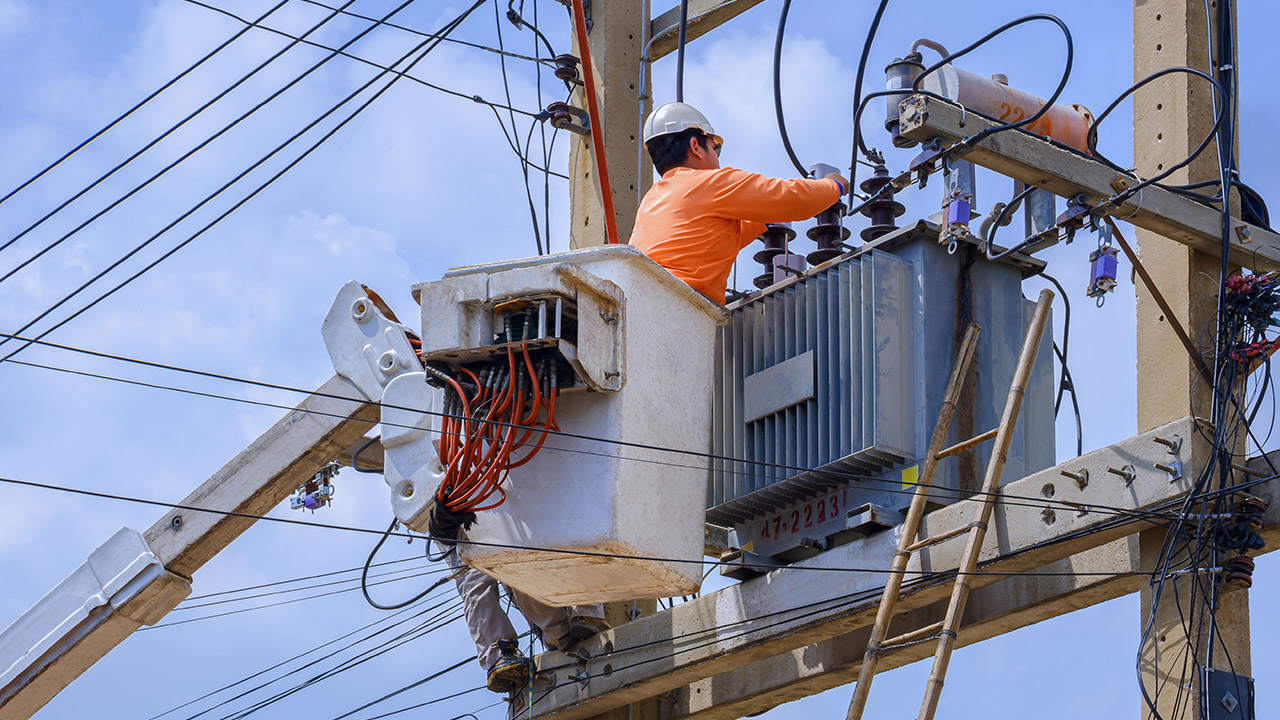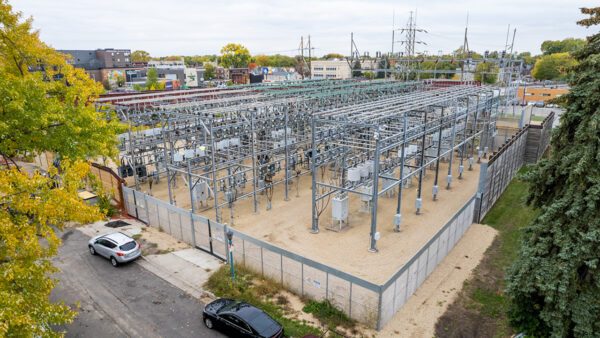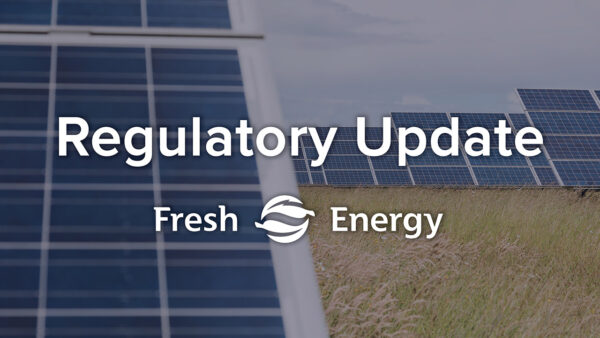
An apple a day keeps the doctor away! So, you buy a subscription to apples—fantastic, right? Well, while your family can eat 20 apples a week, this subscription may deliver anywhere between 10 and 26 apples. Some weeks you feel disappointed by your scant number of apples, some weeks your apples spoil before you can eat them. If only your apples could be delivered at the same rate at which you eat them… but what does this have to do with our electric grid?
Integrated Volt Var Optimization (IVVO) does just that for the electricity delivered to your house or apartment–it optimizes the electricity that is delivered where you live so that the voltage is at the level closest to the level your appliances use. Utilities can shave off this excess voltage difference to make a more efficient system that saves energy, reduces costs, and lowers greenhouse gas emissions for everyone.
Conventionally, there is an acceptable range of voltages that come down to residences (110V to 126V, assuming a 120V base), and it is commonplace for the utility to shoot for the top of the range in their delivery.(1)(2) This results in an inefficient use of electricity, because your appliances are rated for your 120V outlets.
The extra electricity sent to your home may not rot and attract fruit flies like the apples in the earlier analogy, but it is still an unnecessary amount that could be better used elsewhere. If voltage is managed efficiently down the feeder to your home, the utility may be able to produce less electricity generally or forego additional investment, because due to the relationship between watts and volts, delivering power at a lower voltage means you are using fewer watts.(3) So, not only are you using electricity more efficiently (without making any lifestyle changes), but presumably, utilities are deferring costly investments (and saving ratepayers more money). Win-win! Not to mention, less electricity generation means fewer emissions from our dirtiest fuels – win-win-WIN!
As Fresh Energy works to decarbonize our electric grid, IVVO has emerged as a promising way to reduce greenhouse gas emissions in the electricity sector. Keep reading to learn how IVVO works, how it’s already being used by an electric utility in the Midwest, and how Fresh Energy is plugging in to amplify this promising grid efficiency solution.
How Integrated Volt Var Optimization makes the electric grid more efficient
There are two “classes” of power that we deal with on the grid: reactive power and real power. “Reactive power” is required to energize equipment like transformers or power motors, air conditioners, pumps, and other devices, whereas “real power” does the actual work done by the equipment or motor. In essence, real power does the work, but reactive power enables that work to be done.(4)
Electric utilities manage both classes of power through voltage regulation and Volt-Amps Reactive (VAR) regulation. The goal of voltage regulation is to ensure delivery of electricity to your home is within the acceptable range, while the goal of VAR regulation is to ensure mostly real power—the power doing the work—is on the grid.(5) Pair those regulation goals with some technology to best optimize the results and to facilitate two-way communication (such as advanced metering infrastructure, sensors, and modern computing), and you have Integrated Volt-Var Optimization.(6)
Utilities have been using a version of IVVO for years. In fact, the term “brownout” refers to the dimming effect that a lower voltage would have on incandescent lightbulbs.(7) Nowadays, incandescent lightbulbs are not as popular, but other devices such as refrigerators and freezers, furnace fans and heat pumps will consume less energy when operated on a lower voltage.(8) Similarly, resistive devices like water heaters and electric space or baseboard heaters are responsive to voltage reduction; however, these devices ultimately use the same amount of electricity over a longer period. In doing so, peak power can be reduced leading to overall system benefits.(9) That means utilities can match their system goals to how they use IVVO, resulting in a more efficient system that’s better for customers and our climate.
Ameren Illinois is already using IVVO to save energy and lower costs
To see the benefits of IVVO in action, we look to one of Illinois’ largest utilities, Ameren Illinois, which serves 1.2 million electric customers in roughly three-quarters of the state.
One of the ways Ameren Illinois is working to meet its state’s emissions objectives is through increasing its Energy Efficiency (EE) initiatives. IVVO plays a large part in these initiatives, accounting for 15% of the overall energy savings in its EE portfolio.
By implementing IVVO on cost-effective circuits, the utility’s targeted cumulative savings by the end of 2025 is 421.6 GWh PER YEAR.(10) As utility customers, we pay for our electricity in kWh, so, 421.6 gigawatt hours equals 421,600,000 kWh. That is enough kWh savings to power all the electricity needs in my apartment, which has all-electric appliances except for heat and laundry, for about 150,000 years!(11)
Fresh Energy and IVVO
Here in Minnesota, Fresh Energy is engaging in Xcel Energy’s Integrated Distribution Planning (IDP) docket at the Minnesota Public Utilities Commission (read more about distribution planning here). This docket details how the utility plans and operates its distribution system as well as any investments or upgrades it wishes to make. In a past IDP, Xcel Energy proposed to invest in IVVO, but in its most recent IDP Xcel has decided not to pursue the energy efficiency measure—a move that Fresh Energy believes needs to be reconsidered.
Among our priorities in this docket, Fresh Energy is working to amplify IVVO as a potential grid efficiency measure that could optimize the system we already have by conserving electricity and lowering emissions. We need to do everything we can to reach Minnesota’s emissions reduction targets, and IVVO definitely has a role to play!
Sources:
1. Americans for a Clean Energy Grid. (2014) “Integrated Volt-Var Regulation/Optimization [pdf].” Retrieved from: https://cleanenergygrid.org/wp-content/uploads/2014/08/Integrated-Volt-VAR.pdf
2. Ardis, R. and Uluski, R. (26 August 2015) “CVR Is Here to Stay.” T&D World. Retrieved from: https://www.tdworld.com/grid-innovations/smart-grid/article/20965787/cvr-is-here-to-stay
3. US Department of Energy. (2015) “Voltage and Power Optimization Saves Energy and Reduces Peak Power [pdf].” Retrieved from: https://www.smartgrid.gov/files/documents/Voltage-Power-Optimization-Saves-Energy-Reduces-Peak-Power.pdf
4. Americans for a Clean Energy Grid. (2014) “Integrated Volt-Var Regulation/Optimization [pdf].” Retrieved from: https://cleanenergygrid.org/wp-content/uploads/2014/08/Integrated-Volt-VAR.pdf
5. Americans for a Clean Energy Grid. (2014) “Integrated Volt-Var Regulation/Optimization [pdf].” Retrieved from: https://cleanenergygrid.org/wp-content/uploads/2014/08/Integrated-Volt-VAR.pdf
6. Americans for a Clean Energy Grid. (2014) “Integrated Volt-Var Regulation/Optimization [pdf].” Retrieved from: https://cleanenergygrid.org/wp-content/uploads/2014/08/Integrated-Volt-VAR.pdf
7. Ardis, R. and Uluski, R. (26 August 2015) “CVR Is Here to Stay.” T&D World. Retrieved from: https://www.tdworld.com/grid-innovations/smart-grid/article/20965787/cvr-is-here-to-stay
8. Ardis, R. and Uluski, R. (26 August 2015) “CVR Is Here to Stay.” T&D World. Retrieved from: https://www.tdworld.com/grid-innovations/smart-grid/article/20965787/cvr-is-here-to-stay
9. US Department of Energy. (2015) “Voltage and Power Optimization Saves Energy and Reduces Peak Power [pdf].” Retrieved from: https://www.smartgrid.gov/files/documents/Voltage-Power-Optimization-Saves-Energy-Reduces-Peak-Power.pdf
10. Ameren Illinois. (20 January 2023) “Multi-Year Integrated Grid Plan.” Section 5: Distributed Operations.
11. My apartment does not have electric heat nor laundry in the unit, but it does have all electric appliances.



